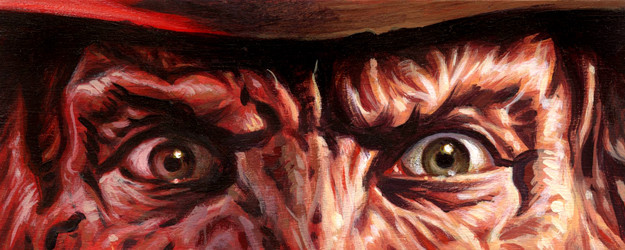I was aware of the terror that is Freddy Kruger long before I ever saw a A Nightmare on Elm Street film. In 1991 or 1992 – I can’t recall the exact year – my family went to the Brisbane Royal Show. Walking through a tunnel, a kid with a hat, a mask and a glove with knives on them jumped in front of us and screamed. I was only about seven or eight years old and was already certain that I didn’t want to see that face again. There were a few other things that made me hate Brisbane, but that was one of them.
I had no idea who or what that face was, but I knew it was something deeply unsettling. I find it an interesting note that the sight of someone dressed up as Freddy Kruger had such a profound effect on me, even though I never knew the relationship of character and film. After the exposure at the Royal Show, I was quite simply terrified with some recurrent nightmares and a few instances of bed wetting. Fortunately, my bed did not eat me whole and paint my room in blood.
One night in 1995, I couldn’t sleep. My Dad on the other hand, had once again fallen asleep in front of the TV – something he still does to this day. As I did sometimes as a kid, I’d creep down the hallway and watch from the darkness whatever film was on the TV whilst he slept. This is how I first watched the Child’s Play series, and also how I first watched A Nightmare on Elm Street. It was also how I first watched The English Patient but that’s a different kind of horror (although Ralph Fiennes in scarred makeup could easily pass for Freddy Kruger).
This was how I saw A Nightmare on Elm Street for the first time, and up until the 3rd of October 2015, it was the only time I’d seen the first film. I’m not sure why it had taken me so long to rewatch it. I’ve watched the sequels countless times and possibly felt that Kruger’s move into a Looney Tunes character coloured my feelings of the original film. However, possibly the reason why it’s been so long is the same reason why I don’t like to watch The Texas Chainsaw Massacre too often – for fear that the film itself will lose its brutal impact over repeat viewings. To neuter the fear out of a horror film makes the film itself redundant and almost pointless.
Wes Craven was a master of horror, there’s simply no denying that. Just like Alfred Hitchcock and Steven Spielberg before him, he managed to turn something so every day and basic into something absolutely terrifying. The terror of Nightmare remains tangible as like with Jaws and the ocean, it takes something so mundane as sleep and makes it horrific. Sleep is inescapable, it’s a world of supreme vulnerability, and it’s perfectly exploited here. The further Heather Langekamp’s Nancy sinks into delirium with lack of sleep and escalating deceased friends, the further we the viewer realises how helpless we really can be.
After boyfriend and all round exceptionally open individual (really, who would talk about breasts like that with their mum?) Johnny Depp gets swallowed whole by his bed and the police swarm his house (even though Nancy tried to warn of his impending death), Nancy becomes trapped in her bedroom. This is made frighteningly explicit with the protective bars that her parents installed to keep the crazy murderous killer out, but instead has only managed to create a prison to keep the entity in. In a wonderful nod to what real horror is, Craven doesn’t show us the assumed mangled mess that would be Depp’s body after his bed eats him. Instead, he relies on the police officers reactions to further amplify the horror, allowing our minds to fill in the blanks.
This is the aspect of Nightmare that works so well with Craven using the ‘less is more’ approach to horror. By hardly showing Kruger and keeping him in the shadows, it amplifies the terror when he does appear and make his presence completely known. Even though I personally view films with the mentality of the era that they were made, the practical effects and the minimal usage of Kruger helps make this film an ageless entity.
Nancy trapped in her bedroom helps push the idea that we are alone in conquering our fears. In this moment alone, Nancy is cemented as one of the great horror heroines. Her ability to stand up for herself and fight Kruger alone makes her a heroine to look up to.
The iconic moments – like the glove in the bathtub or Johnny Depp’s bloody death – are ones that stick in your mind. However, the glue that binds these moments together work perfectly with believable characters that are created from a perfectly written script. You care about these characters and you care about their fates. Yes, they are young teenagers who just want to have fun, but you buy into that stereotype completely.
Overall, if you haven’t seen A Nightmare on Elm Street in a while, then really, now is the time to rewatch it. The campy sheen Kruger emanates in the sequels are quickly forgotten within minutes of the original as Kruger walks along with a bleeting sheep.



